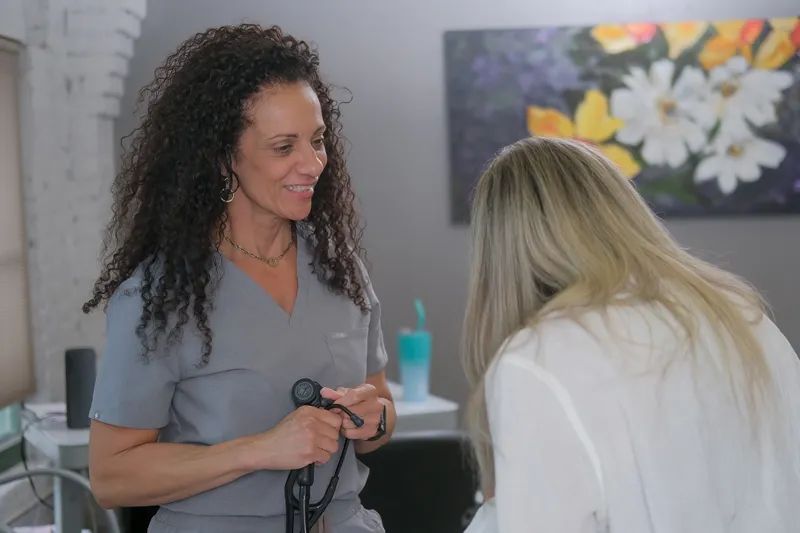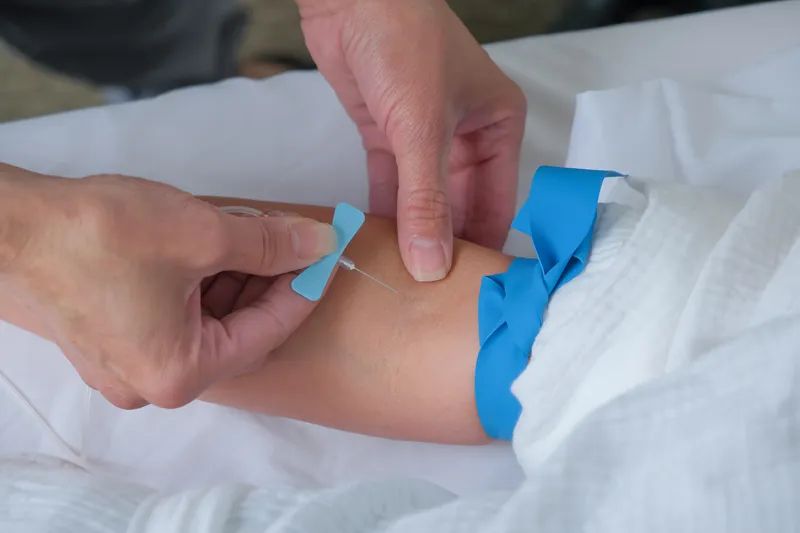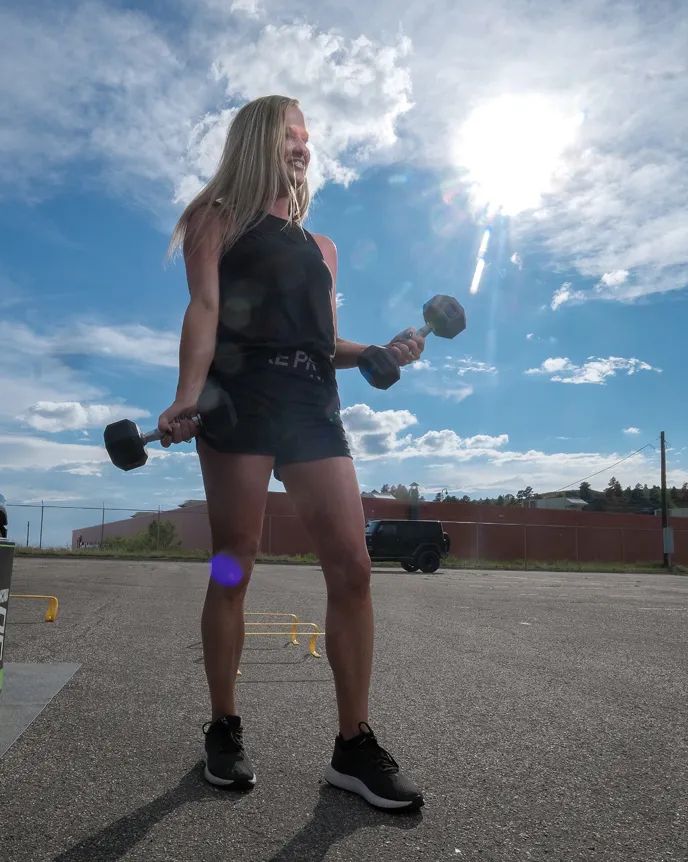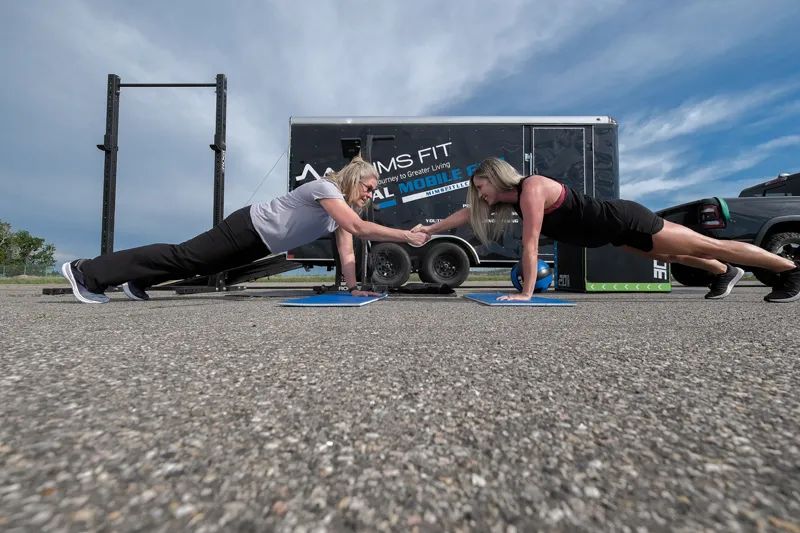
Grow old gracefully? On whose terms?
Two Billings women join forces to promote health after 40
When Mistie Mims and Stephanie Morup first crossed paths at the YMCA, they shared a goal of improving their overall health. Little did they envision then, during that long-ago boot camp, that one day they’d be helping each other attain that shared goal. Nor did they foresee that they’d be dovetailing their expertise — in hormone therapy, fitness and nutrition — to help others navigate the over-40 divide.
Mistie, the former fitness director at the YMCA, is a certified personal trainer, health coach and sports nutritionist. She and her husband, Jaysun, make up Mims Fit, a health and fitness business they started eight years ago.
Stephanie is a PA-C (certified physician assistant) who specializes in hormone therapy — specifically bio-identical hormone replacement therapy (B-HRT). Formerly with Premier Aesthetics, she recently opened her own business, MorUp B-HRT.
While their business ventures remain separate, both Mistie and Stephanie agree that optimal health can be achieved only by addressing the overall body — and that includes fitness, nutrition and hormonal balance.
“It goes hand in hand,” Mistie explains. “You can’t have one without the other.”
Besides sharing that philosophy, the two share similar experiences that led them to the work they’re doing today. Their personal stories – of the changes they faced when they entered their 40s – sharpened their focus. Both now share a passion for helping other women work through life’s changes.
“People say we should age gracefully,” Stephanie says. “But what is aging gracefully? And on whose terms?”

Now 52, Stephanie had a complete hysterectomy at 40. To address the sudden changes that came with it, she was prescribed synthetic hormones that left her with weight gain, irritability and bloating. Frustrated, she quit the hormones and worked her tail off in the gym. But the scale wouldn’t budge.
“I hit (gained) 50 pounds and was feeling miserable,” she says. “It would have been worse if I wasn’t a gym rat.”
She went to three providers before finding a doctor who addressed her symptoms with information and B-HRT. She started feeling better. She lost weight and kept it off. The change made her a believer.
Delving further into the latest research, she came away convinced that a flawed study was at the root of hormone therapy’s bad rap. Her research also convinced her that bio-identical hormones — rather than synthetic hormones — are the key to minimizing any risk associated with HRT.
Energized by the changes she experienced personally, Stephanie enrolled in courses in Salt Lake City through Dr. Neal Rouszier, considered by many as the “guru” in B-HRT.
“Now we can look at aging by treating aging as a disease,” she says. “We have medicines for blood pressure and diabetes; why not treat this?”

THE BIO-IDENTICAL CONNECTION
As Stephanie explains it, when women hit pre-menopause and menopause, many find themselves suffering from a host of issues including irritability, depression, hot flashes, foggy thinking, lack of sexual desire, difficulty sleeping and vaginal dryness, among others. Long term, the drop in hormones can also lead to heart disease, diabetes, osteoporosis and other health issues.
Though it’s known that hormones can relieve some of these symptoms, providers have been reluctant to prescribe them. The hesitancy traces to the 2002 Women’s Health Initiative Trials that tested the use of synthetic hormones in older women already dealing with health issues such as diabetes and heart disease. When early indications suggested that the hormones increased the risk of cancer, even slightly, the study was terminated and the use of hormones was virtually abandoned.
“The reality is, these women were ill anyway,” Stephanie said. “Because of that study, they said all hormones were a problem.”
Yet, that’s not the end of the story. A subsequent study in JAMA (Journal of the American Medical Association) in 2017 revealed a totally different outcome. It found that the women who had remained on hormones long term actually benefited from them, that the hormones were protective and increased longevity. It also revealed that bio-identical hormones offered a better alternative for improved health outcomes and less risk overall.
“It didn’t make sense,” Stephanie asays. “We were making these hormones before (menopause), so why would they suddenly be dangerous?”
Likewise, she points out, commonly prescribed birth control pills contain the very same hormones and yet have not been pulled from the shelves. To address the misguided bias against hormone therapy, Stephanie relentlessly strives to get her message across.
“Educate, educate, educate,” she says.

She is a strong proponent of bio-identical hormones because they more closely match the genetics of a women’s natural hormones, she says. They are compounded from plants such as soy and yams, as opposed to Premarin, which is synthesized from the urine of pregnant mares.
Stephane emphasizes that her practice is not limited to women. Men, too, can suffer from hormone imbalance. When testosterone levels are too high, the symptoms include acne, aggression, early puberty, high blood pressure, low sperm count and even increased risk-taking behaviors.
An appointment with Stephanie involves a thorough medical exam, lab work and a discussion about the patient’s symptoms and goals. Once the lab results are in, Stephanie works with her patients to tailor their treatment.
“My goal is to have them understand the pros and cons, to educate the patient so they decide what’s right for them,” she said.
And this is where Mistie comes in. Struggling with her own post-40 problems — in a matter of months she’d put on 25 pounds and felt out of whack — she, too, made an appointment with her doctor.
“My physician said, ‘Welcome to your 40s,’” she says.
Refusing to accept that, Mistie eventually figured out that her issues were related to hormonal changes. She continued working out and simultaneously opted for BHRT under Stephanie’s counsel. Getting her hormones back in balance helped with her sleep, her energy level and even lessened her brain fog, she said.
Now, at 49, Mistie is back at her desired weight and feeling great. She credits Stephanie for her thoroughness, her knowledge, her accessibility and even her affordability. And she appreciates Stephanie’s passion for what she does.
“Because of where Stephanie has my hormones, I feel like I did in my late 20s, early 30s,” she says.
Yet, both women agree that hormones alone won’t help with weight loss and fitness.
“I have found, and so has research, that the key to success if you want to be fit after 40 is to adjust your priorities to be more health-oriented,” Mistie says.
A woman’s metabolism slows as she hits middle age, and with that, her need for calories also drops, she adds. Having gone through her own struggles, Mistie, like Stephanie, has focused on helping women in that age group.

“(With balanced hormones) you still need to work at it, but it’s easier,” Mistie says. “We just have to work out differently.” For one, “differently” means making workouts more efficient and targeted, she says.
“Once you’re in your 40s and older, it’s less about cardio and more about weight training,” she says. “Weight-bearing exercise prevents osteoporosis and a decline in muscle mass.”
The difference is also about finding the right approach to make workouts less daunting for those who might be exercise-shy or think it’s “too late.” To establish a routine, Mistie schedules sessions with her new clients for two or three days a week. Mistie is all about taking baby steps, coaching patience and tailoring workouts to make her clients enjoy what they’re doing. She reminds them that results take more time in middle age, but that ultimately they will look and feel better. More importantly, their commitment to healthy living will decrease their chances of developing serious health issues later on, she adds.
Just as Mistie has relied on Stephanie’s expertise, Stephanie has benefited from Mistie’s wealth of experience. Stephanie discovered that, even with her hormones in balance, she’s having to change up her workouts.
“I learned that you can’t just go on a walk and that be enough,” she says. “You can’t just lift weights and that be enough. You have to find ways to shock your metabolism. You’ve got to mix it up.”
As the two reconnected through their practices, they started referring clients to each other.
“Of all my clients who’ve gone to hormone replacement therapy, not one has regretted it. Not one,” Mistie says.
Above all, Stephanie and Mistie agree that no one should accept a dead-end diagnosis of “welcome to your 40s.”
“Some people feel they’ve missed out on the opportunity to be fit if they’re 40 and out of shape,” Mistie says. “But that’s simply not true, because it’s not too late. Just like it’s not too late to change your career after 40.”
DID YOU KNOW?
It’s estimated that upwards of 2.5 million women in the U.S. over the age of 40 are using bioidentical hormone replacement therapy.











